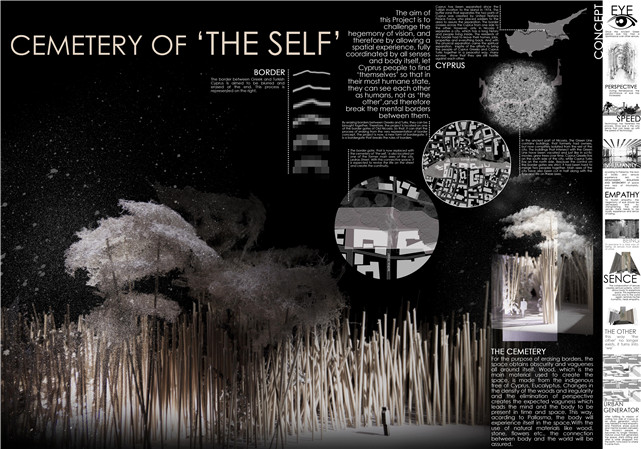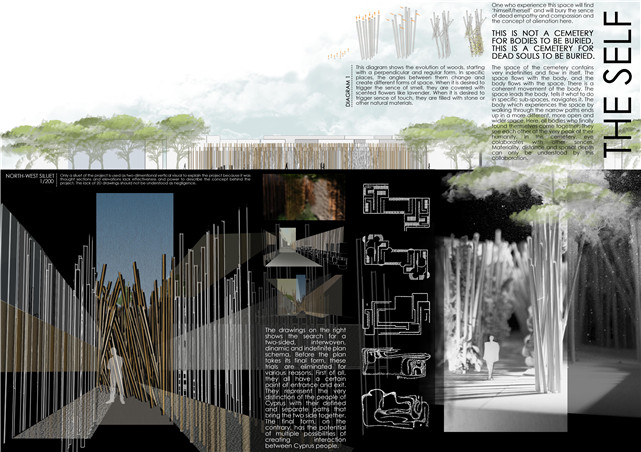当前页面 >> 评审结果
Cemetery of The ‘Self’
学生姓名:Ümmiye Şeyda Çağlan, Semahat Merve Top
项目名称:Cemetery of The ‘Self’
指导老师:Ramazan Avcı
学校名称: TOBB ETU University of Economics and Technology
This project mainly aims to bring about an opinion on how to solve a particular humanitarian issue in a particular part of the world. Cyprus, with its divided lands and people was a troubled area that we can relate its problems to ourselves. In Cyprus, one of the biggest problems that human race can face was waiting for us to think about: alienation. The two people of Cyprus, Turks and Rums, do not see each other as one of their kinds, a friend, and a family, someone to live with. But they see each other as an enemy, someone that you should be careful with. The‘other’. We wanted to show them that this does not have to be the case. That they have the same kind of lifestyle, same thoughts, same needs, same feelings and so on. And the way to do this was to break all borders between them, both physical and mental. 
Juhani Pallasma, in his book Eye of the Skin, states that the hegemony of the eye weakens our capacity of empathy, compassion and participation with the world. So, by challenging the hegemony of the eye, by strengthening other four senses and create the conditions for all five senses to work together in harmony, it is possible to attach a person to the world, as in here to space, and ensure the bodily experiment and self-perception of space. Bodily experiment builds the relation between the self and the world. Being aware of the self leads to be aware of other selves, understand other human beings and transforms the ‘other’ to ‘we’.
The program chosen is a cemetery. But material bodies should not have been buried in this space. On the contrary, whatever it is dead inside, empathy, love, understanding, compassion, kindness, unity, etc. were supposed to be buried and there should be a rebirth of the self. The architectural tools to create such space are natural material use, flexibility, loss of perception both horizontal and vertical, triggers of other senses, body movement, mobility, freedom and complexity. It is a space that captures the people of two sides, Turks and Rums, makes them go through their own journey with themselves in the space, makes them get in touch with their selves, helps them understand themselves as human beings and then finally brings them across with each other.
Cyprus has been separated since the Turkish annexation of the island in 1974. A border crosses across the Cyprus from one side to the other. However, only in Nicosia it separates a city, which has a long history and people living inside. With the physical separation came the spiritual separation. For the purpose of erasing borders, the space obtains obscurity and vagueness all around itself. Changes in the density of the woods and irregularity and the elimination of perspective create the expected vagueness which leads the mind and the body to be present in time and space. The space of the cemetery contains very indefinites and flow in itself. The space flows with the body, and the body flows with the space. The space leads the body, tells it what to do in specific sub-spaces, and navigates it. Here, all bodies who finally found themselves come together. They see each other at the very peak of their humanity.

People coming from each side first go through the paths that enable spatial experience and that bound the body to the reality and humanity. Then, they get together to look each other one more time, this time to see something different, something similar. The paths vary in different ways. After, hopefully, the mental borders are erased; this cemetery ends its mission as an urban generator. Woods start joining to the earth and disappear.